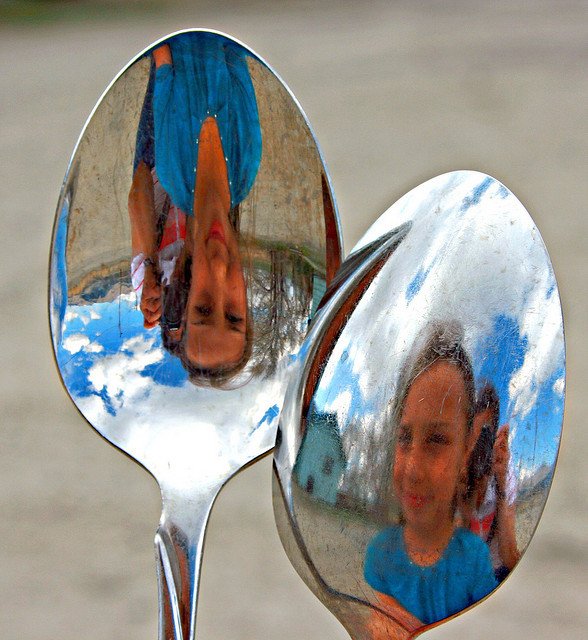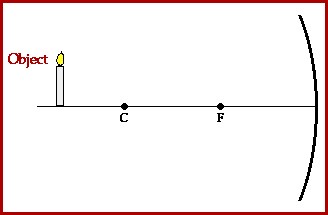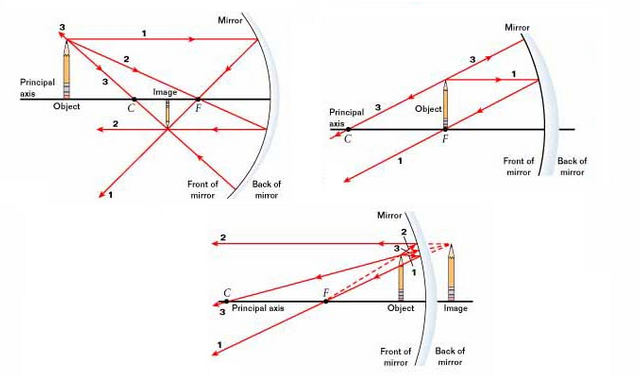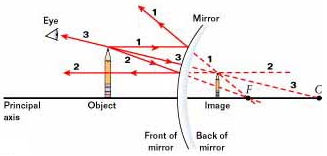Images In A Spoon - The Physics
Spoons As Mirrors
When you think of a mirror, chances are you picture a typical bedroom 'plane mirror'. However, any reflecting surface, planar or otherwise, can act as a mirror, and this is why many baubles and lenses are 'shiny'.
Even the humble cereal spoon can act as a type of spherical mirror, which many of us discover as children procrastinating at the breakfast table. Particularly curious children might notice that their reflected image appears upside down in the concave surface of a spoon but the correct way up in the opposite convex surface.

https://goo.gl/EPZo87
To explain this phenomenon, we need to understand how rays of light leaving an object form an image en route to our eyes via a reflecting surface.
Ray Diagrams
When describing the formation of images in a mirror it is useful to set up a ray diagram. These graphic representations have a number of important features which, when understood, allow us to predict the properties of an object's image:
- For spherical mirrors, an optic axis can be drawn from the sphere's centre of curvature to the vertex on the mirror's surface. Any rays parallel to the optic axis will reflect through the mirror's focal point, which is found halfway between its centre of curvature and vertex. By the same token any rays passing through the focal point will reflect parallel to the optic axis.

https://goo.gl/HWEaxm
- Any rays which meet the mirror's surface at the optic axis (i.e. its vertex) will reflect at the same angle as their angle of incidence in the same way that all incident rays to a plane mirror do.
- All rays passing through the centre of curvature reflect directly back through it again.
Images In A Spoon's Concave Surface
Let's put these principles into practice and inspect some ray diagrams for a pencil reflected in the concave surface of a mirror:

https://goo.gl/41XbWH
Diagram 1) Here the pencil is located further from the mirror than the focal length F.
We can draw three outgoing rays from the pencil and find the point at which an image forms by finding the intersection of these lines. Note that, for an object beyond the focal point of a spherical mirror, the image is inverted.
This explains an upside-down image in the concave surface of a spoon, since the viewer is usually further from the spoon than its small focal length (half its radius of curvature).
An image formed in this way is considered a real image: the rays of light really do intersect at the image point.
Diagram 2) Now the pencil is placed at the focal point of the mirror. According to our ray diagram rules, the reflected lines are parallel and the image is said to form at infinity.
Diagram 3) Now we come across a situation in which the image formed is not real; the pencil is moved to within the focal length of the mirror and we find that all three reflected lines diverge rather than meeting at a point of intersection.
The only way for a viewer's brain to make sense of the incoming rays is to assume they originate from a point behind the surface of the mirror - this is represented by the dotted lines, which intersect to form a virtual image (since the rays never actually meet, the image is not considered real).
It makes sense to interpret diverging rays as light coming from this imaginary point, since they must converge in the opposite direction.
You may also notice that the virtual image of the pencil is upright rather than inverted.
As you move a spoon towards your face, there comes a point (provided the spoon is big enough) that you pass its focal point and your image 'flips' from inverted to upright.
Image In A Spoon's Convex Surface
Now we'll consider the opposite surface of a spoon:

https://goo.gl/AqUygD
Although the pencil is no longer on the same side of the spoon as the focal point, the same principles apply to drawing the ray diagram: rays towards the focal point are reflected parallel to the optic axis and rays parallel to the optic axis are reflected directly away from the focal point as if leaving it.
Clearly these reflected lines do not converge to form a real image, but by extending them beyond the mirror's surface (as our brain does automatically) we find a point from which it appears the rays originated.
An upright, virtual image is formed.
Indeed, the virtual image of our face appears the correct way up when viewed in the back of a spoon.
While this isn't a suggestion that you should throw out your bedside mirror in favour of a box of cutlery any time soon, being able to explain such phenomena can be useful. An understanding of the way in which light interacts with non-planar reflecting surfaces like spoons is crucial for scientists making all types of optical equipment, from glasses lenses to space telescopes.
If you enjoyed this article or are interested in all things science, follow my blog for daily doses of physics and chemistry, along with explanations for curious everyday phenomena.
References:
University Physics with Modern Physics by Young and Freedman
This is the kind of content I enjoy on steemit! Thanks for contributing to #science and #steemstem . Followed and waiting for your next posts ;-)
Appreciate it, plenty more to come!
very cool, i can see your posts rock, scientifically speaking ! great stuff
Thanks for your kind response - very glad you enjoyed my article, more to come daily!